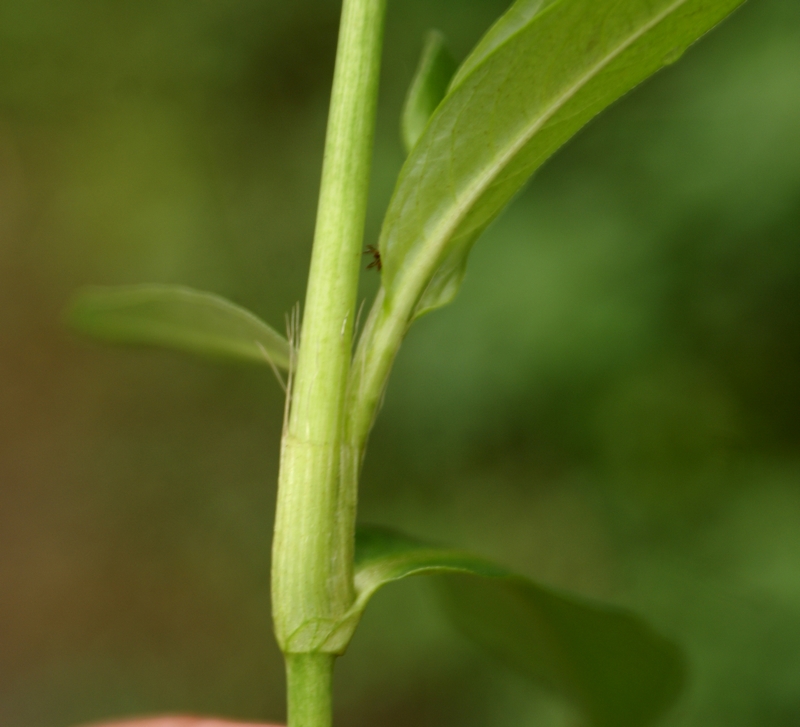|
Persicaria decipiens (R.Br.) K.L.Wilson, Telopea 3: 178 1988. (syn: Persicaria minor subsp. decipiens (R.Br.) Soják; Persicaria salicifolia (Brouss. ex Willd.) Assenov [Illegitimate]; Persicaria serrulata (Lag.) Webb & Moq.; Polygonum decipiens R.Br.; Polygonum salicifolium Brouss. ex Willd.; Polygonum serrulatoides H.Lindb.; Polygonum serrulatum Lag.);
. Tropical & Subtropical Old World to Australasia: Albania, Algeria, Angola, Assam, Baleares, Bangladesh, Benin, Botswana, Bulgaria, Burkina, Burundi, Cameroon, Canary Is., Cape Provinces, Cape Verde, Caprivi Strip, Central African Repu, Chad, Chatham Is., China Southeast, Congo, Corse, Cyprus, East Aegean Is., Egypt, Ethiopia, France, Free State, Gabon, Gambia, Ghana, Greece, Guinea, Gulf of Guinea Is., India, Iran, Iraq, Italy, Ivory Coast, Kenya, Kriti, KwaZulu-Natal, Lebanon-Syria, Lesotho, Liberia, Libya, Madeira, Malawi, Mali, Morocco, Mozambique, Myanmar, Namibia, New Guinea, New South Wales, New Zealand North, New Zealand South, Niger, Nigeria, Norfolk Is., Northern Provinces, Northern Territory, Palestine, Portugal, Queensland, Rwanda, Sardegna, Senegal, Sicilia, Sierra Leone, Somalia, South Australia, Spain, Sri Lanka, Sudan, Tanzania, Tasmania, Togo, Tunisia, Turkey, Turkey-in-Europe, Uganda, Victoria, Western Australia, Yemen, Zambia, Zaïre, Zimbabwe as per POWO;
. Common name: Willowleaf Knotweed, Willow-Leaved Knotgrass
. POLYGONACEAE FORTNIGHT 1-14 May 2014: Persicaria glabra from Uttarakhand_DSR_6 : 6 posts by 3 authors. Attachments(1).
Persicaria glabra (Willd.) M.Gomez is a common wild herb along drainage channels in Pantnagar.
Shot at Pantnagar, Uttarakhand. Could you please share some more pics here Sir? Somehow it looks more like P. barbata to me. Not sure though. Yes with your observation and following post by …; Thank you … for correcting the ID. It is P.barbata var. gracilis vide eFlora Pakistan- However, the image on the same page in Annotated Checklist of the Flowering Plants of Nepal
have a different Ochrea. Must be a different var.
Attaching few more pics to show ochrea, leaf margin cilia, ochreolae and nuts. Welcome to this eFI group … It seems that I am the first person directly benefited by your expertise in Polygonum s.l.
Thank you for indicating towards important characters of P.serrulata which is now known as P.decipiens (R.Br.) K.L.Wilson as per The Plant List 2013.
If I am not wrong it is the same species once known as Persicaria salicifolia (Brouss. ex Willd.) Munshi & Javeid.
I also consulted a century old (but still relevant) Flora of Upper Gangetic plains which differentiates P.barbatum and P.serrulatum as-
Lvs tapering to the acute base, marginal cilia of ochreae longer than tube…………………………..Polygonum barbatum
Lvs tapering to rounded or subcordate base, marginal cilia of ochreae not longer than tube……..Polygonum serrulatum
Accordingly my plant is P.serrulatum. eFlora Pakistan does not has this species and I wrongly concluded to P.barbata.
I hope the ID is now fixed to Persicaria decipiens (R.Br.) K.L.Wilson (=Persicaria serrulata);
Thanks to … Polygonaceae Fortnight: Persicaria hydropiper from Dakpathar in Uttarakhand pl. validate-GSMAY34 : 5 posts by 4 authors. Attachments (5).
Perhaps Persicaria hydropiper photographed from near Dakpathar in Uttarakhand.
Please validate or give correct ID efi page on Persicaria hydropiper Inflorescence is usually lax in P. hydropiper.. here it is dense. I can also see faint red blotches on leaf in the first photograph… which are not found in P. hydropiper. More characters (i.e. nuts and perianth) should be checked for the proper ID. In light of the discussion in another thread Polygonum for id 150211MK1:
Please help to is this Polygonaceae member. I hope the genus is Polygonum sp. I found this single individual in a first-order stream among P.glabrum population. The location is on the eastern most part of Nilgiris district in TN. Date/Time- 10-02-2011 / 11:00 AM
Location- Place, Altitude, GP stream in Nilgiris RF; TN. c 350 msl Habitat- Garden/ Urban/ Wild/ Type- wild, wetland Plant Habit-herb Height/Length- c. 50 cm Leaves Type/ Shape/ Size- c. 10 X 1 cm; Violet blotches in mid of leaf Inflorescence Type/ Size- raceme; upto 10cm long Flowers Size/ Colour/ Calyx/ Bracts- white Germanname Knöterich. But I have this weed in my garden in Ritterhude, not just white but redisch too. I don’t think I have a foto of the red one. Will send some in summer. seems to be Polygonum barbatum Leaves with dark blotches in middle, spikes dense and compact. Persicaria maculosa from me. Thank you .. for the identification. Polygonum barbatum have ciliated ochre I think it appears close to images at Persicaria decipiens (R.Br.) K.L.Wilson as per comparative images at Persicaria. .
     Persicaria for ID from Baijnath Uttarakhand-GS19032022-1: 5 very high res. images. Please help with the ID of Persicaria sp photographed from Baijnath, Uttarakhand, 15-4-2012. Try to check with comparative images. To me appears close to images at Persicaria decipiens (R.Br.) K.L.Wilson as per comparative images at Persicaria |










